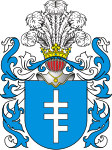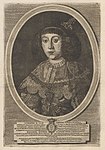Piława coat of arms
| Pilawa | |
|---|---|
 | |
| Battle cry | Pilawa |
| Alternative name(s) | Pilawa, Strzała |
| Earliest mention | 1385 |
| Families | show 160 names |
| Cities | Baltiysk, former town of Piława, Buczacz, Monasterzyska, Jabłonów, , , Tłuste (Tarnopil oblast), , Tyśmienica, Bodzanów, Złotniki, Stanisławów, Brody (Lviv oblast), Krystynopol (Lviv oblast), Czerwonogród (Tarnopil Oolast), Horodenka |
| Gminas | Gmina Krzeszowice, Gmina Nałęczów |
Pilawa (Polish pronunciation: [piˈlava]) is a Polish coat of arms. It was used by many noble families known as szlachta in Polish in medieval Poland and later under the Polish–Lithuanian Commonwealth, branches of the original medieval Piława Clan (Pilawici) family as well as families connected with the Clan by adoption.
History[]
The progenitor of the Pilawa Clan was supposed to have been , who was fighting the Prussians, a pagan tribe and brought himself glory in the , where he fought along Bolesław IV the Curly. The legend states that Żyrosław reached the pagan chief, fought him in hand-to-hand combat and killed him. The terrified enemy hordes fled the battle field. The related legend tells also that in 1166, to commemorate the victory, Bolesław IV bestowed a coat of arms upon Żyrosław, naming it for the place, where the battle took place.
Blazon[]
The Pilawa coat of arms assumed its final form in the late 14th century. Formerly, there were two differing patterns, and the records from the years 1387, 1388 and 1389 mention that it had to be a letter "Z" with two and a half of a cross, or an arrow with two and a half of a cross.
Notable bearers[]
Notable bearers of this coat of arms have included:
- House of Potocki
- Mikołaj Potocki
- Jan Potocki
- Antoni Protazy Potocki
- Roman Ignacy Potocki
- Stanisław "Rewera" Potocki
- Józef Potocki
- Andrzej Potocki
- Feliks Kazimierz Potocki
- Katarzyna Potocka
- Alfred Józef Potocki
- Alfred Wojciech Potocki
- Roman Potocki
- Stanisław Kostka Potocki
- Józef Potocki
- Franciszek Salezy Potocki
- Stanisław Szczęsny Potocki
- Teodor Andrzej Potocki (Golden Piława)
- Wiktoria Elżbieta Potocka
- Anna Stanisławska
Family name changes during the Second World War and 1944–1953[]
The communist government of Poland was in deep opposition to every rich (specially noble) family. Hundreds of Potockis were killed by NKVD and Red Army. Many Potockis, who decided to stay in Poland were forced to change their family names (otherwise they could be killed, imprisoned or have other problems).
The most popular changes was from Potocki to Nowak, Kowalski, Gnejowicz, Stanisławski, Pryszkiewicz, Wszelaki, Petecki, Blacha, Musiał, Woldan, Walera, Melka, Madej and Pastuch.
Gallery[]
Piława coat of arms in Baranow-Sandomierski castle

Silver Piława

Golden Piława

Coat of arms of Counts Potocki

Piława at the Potocki mausoleum at Wilanow Park
Piława at the

Piława at the Lańcut Castle
Piława at Leżajsk monastery

Piława and the Prices Czartoryski coat of arms in Lańcut Castle

Piława and the Szreniawa coat of arms of the Prices Lubomirski in Lańcut Castle

Piława and the Topór coat of arms in Lańcut Castle

At Tyszkiewicz Palace in Warsaw

Piława at the Palace in Antoniny, Ukraine
Piawa at St.Martin Church in w Krzeszowice

Wilanów Palace

Former coat of arms of Stanisławów (Iwano-Frankiwsk)
Paintings
Piława on the painting of Stanisław Potocki
Piława on the painting of Mikołaj Kamieniecki
Piława on the painting of Teodor Andrzej Potocki
Golden Piława on the painting of Mikołaj Bazyli Potocki

Piława on the painting of Katarzyna Potocka
See also[]
- Polish heraldry
- Heraldic family
- List of Polish nobility coats of arms
External links[]
- J. Lyčkoŭski. "Belarusian Nobility Coats of Arms". Pilawa Coat of Arms and the bearers (in English)
Bibliography[]
- Tadeusz Gajl: Herbarz polski od średniowiecza do XX wieku : ponad 4500 herbów szlacheckich 37 tysięcy nazwisk 55 tysięcy rodów. L&L, 2007. ISBN 978-83-60597-10-1.
- Polish coats of arms
- Clan of Pilawa






















